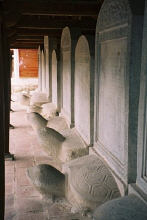Backwards in Hanoi
Hanoi, Vietnam
A woman in leggings and a baggy t-shirt is attempting to jog backwards, waddling like a disorientated duck, arms pumping and sweat pouring while we watch on smugly, lazily sitting on tiny plastic chairs drinking cold Sprites and Fantas. We are in Lenin Park in Hanoi and it is 6am and already warming up. I think I will be resisting the temptation to go running backwards today.
The park somehow contrives to feel busy and peaceful all at once; people performing rigorous, uninhibited if sometimes comical, exercises while others sit around chatting. All are taking advantage of the relative cool of the early morning before the suffocating heat and humidity hits. Then the canopies of the many trees will provide shade for groups playing cards, chess, draughts or those just dozing. It will be the men who sit gossiping, split into generational groups, old men smartly dressed and young men with t-shirts pulled up above their midriffs, hoping for a breeze to cool their backs.
Lenin Park was apparently once Hanoi’s dumping ground for household waste. Those days are gone and in its place is one of the most beautiful parks in Hanoi. Initially named Reunification Park it was renamed Lenin Park after the Soviet Union befriended Vietnam during the American/Vietnam War. Situated around the lake are gardens, paths and statues, mostly thanks to the enterprises of Ho Chi Minh.
Currently the marble square is occupied by grannies with grey perms and middle-aged mothers in an assortment of matching tracksuits. They seem to be practising some kind of martial art fitness regime, swords waving and thrusting to the sounds of a stereo nearby. Elsewhere people are playing badminton, football or just jogging, sometimes even forwards.


Temple of Literature
![]()
![]() We leave and decide to head to the Van Mieu, otherwise known as the Temple of Literature. It is not yet 9am and getting very hot. The temple gardens are well kept, quaint and pretty and would probably be peaceful were it not for the children on a school outing and their teacher chaperones with megaphones. Linear manicured hedges and trees line the paths into the various courtyards, where some of the best traditional Vietnamese architecture can be found. Ornate, red gold plated altars and stone stelae (commemorative stone slabs resting on the shells of stone turtles) recording successful doctorates are some of the other sights that can be found among the courtyards and gardens of the temple. Founded in 1070 by Emperor Ly Thanh Tong, the Temple is Vietnam’s first university.
We leave and decide to head to the Van Mieu, otherwise known as the Temple of Literature. It is not yet 9am and getting very hot. The temple gardens are well kept, quaint and pretty and would probably be peaceful were it not for the children on a school outing and their teacher chaperones with megaphones. Linear manicured hedges and trees line the paths into the various courtyards, where some of the best traditional Vietnamese architecture can be found. Ornate, red gold plated altars and stone stelae (commemorative stone slabs resting on the shells of stone turtles) recording successful doctorates are some of the other sights that can be found among the courtyards and gardens of the temple. Founded in 1070 by Emperor Ly Thanh Tong, the Temple is Vietnam’s first university.
By this point the heat and humidity is becoming unbearable and my t-shirt is embarrassingly soaked, so it is with immense gratitude that I enter the cool corridors and air-conditioned rooms of the Fine Arts Museum. The paintings and sculptures weren’t bad either.


Stone Stelae
![]()
![]() Much to my relief the afternoon is spent hidden away in our guesthouse room below a helicopter fan; if an afternoon snooze is good enough for many locals, it is good enough for me.
Much to my relief the afternoon is spent hidden away in our guesthouse room below a helicopter fan; if an afternoon snooze is good enough for many locals, it is good enough for me.
The day is not yet over. We are finally going to get round to visiting the Thang Lang Water Puppet Theatre, just to the north of the Hoan Kiem Lake in the Old Quarter. Mua Roi Nuoc or water puppets were developed in the Red River Delta and in ancient times were staged in ponds or rice paddies. These days the puppeteers have their own seated theatre, complete with acoustics and smoke machines. The puppeteers stand behind a screen and control the puppets using various string and bamboo mechanisms hidden beneath the water surface, performing intricate movements accompanied by loud singing and traditional music. Many of the scenes appeared to relate to Vietnamese cultures and work, interlaced with numerous comedy moments. Oh, and if you buy a ticket for the posh seats at the front you get a free cassette of the music. Does anyone still have cassette players?